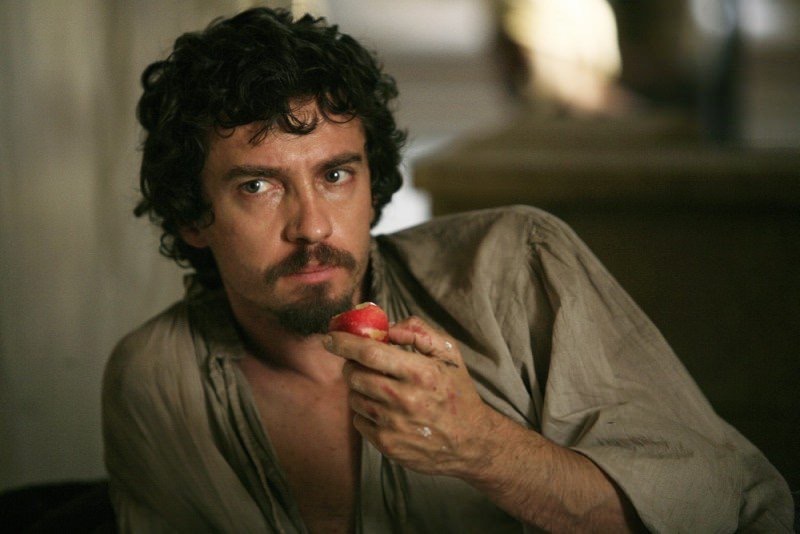Derek Jarman’s "Caravaggio": A Bafflingly Beautiful Sketch of a Troubled Artist
Derek Jarman’s Caravaggio is a perplexing and often dizzying tale of the troubled life of the sixteenth century Baroque artist, filled with puzzling voice-overs and dodgy plot devices, the film shakes you back and forth between twenty or so years of Caravaggio’s tormented life.
The story starts with an ill Caravaggio mumbling dazed poetry to the viewer from his deathbed, and then jumps back and forth, bafflingly so, from the artist’s beginnings in Rome, to his love affair the bad boy street fighter Rannucio and his lover Lena, then back to his deathbed, then back to Rome, so on and so forth.
Jarman seems to use this passionate love triangle between Caravaggio, Rannucio, and Lena to justify the reasoning behind some of Caravaggio’s most poignant works and goes to obvious lengths to position actors as mirror images of the artist’s work. At times it seems like an obnoxious attempt to create parallels, as if to remind the viewer, “Hey, remember this is the story of an artist who painted this! You know, because he’s an artist…who painted this.”
The late Nigel Terry brilliantly embodied our troubled artist in both likeness and swagger (if one were to put a portrait of Caravaggio next to Terry’s, it’s as if the man himself is the one madly pacing up and down the low-lit set). Being as it was both of their film debuts, Sean Bean as Rannucio and Tilda Swanson as Lena seemed prime and ready for the picking, though they clearly did not become the great actors they are today overnight in 1986.
Jarman and cinematographer Gabriel Beristain seem more interested in this visual aspect in the film than the emotional depth of the story itself. There is a missing layer of character, not by fault of any of the actors, who delt well with what they were given to work with. It’s almost as if a part of the story’s meat got lost in the homoerotic sauce. The result is a story attempting to convey the trials and tribulations of Caravaggio but only just scratching the surface. Much more could have been done to characterize Caravaggio himself through other means than just poetic voice-overs and a well-done set.
That being said, from a cinematography standpoint, the personalization of dark tenebrism and fleshy overtones, as well as the juxtaposition between the dirty and clean, the church and the sinner, the wealthy and the poor—all blend beautifully to visualize the complex and often dingy sixteenth century Italy. Caravaggio himself also seems to embody both of sides of this unfortunate coin. Life during the Renaissance isn’t all God-loving, life-changing art or once-in-a-lifetime thinkers, and Jarman does well to remind us of that.
If it weren’t for its jumpy time skips and the bouts of bizarre borderline homoerotic poetry, I’d say Jarman did well to depict the life of a criminal slash murderer slash gifted artist. Not to say that there is anything wrong with homoeroticism, but in this context, it almost seems like a forced narrative to try and keep things interesting (because what fun is the life of a troubled artists if we aren’t also indulging in all his bisexual plights). The real artist was, as the records show, an arrogant and rebellious, a drunkard and privileged troublemaker who was exiled to Naples after killing a man, and later died of what was probably malaria.
The personality Jarman and Terry paints is that of Caravaggio’s presumed likeness. As it seems, Caravaggio also did not paint like other artists. He did not sketch before his paintings and preferred to paint directly onto the canvas. He often hired random people off the streets like drunkards and prostitutes to model for his paintings. He fought, he drank, he had lots of sex, he killed a man or two. All of which is embodied quite well in this film.
Jarman’s seemingly random use of anachronisms is another layer perplexing plot devices. From the use of filtered cigarettes, automobiles in barns, typewriters suspended over baths, a random green truck strategically placed so Caravaggio could display some more of his bad-boy artist one-shouldered lean. There doesn’t seem to be a rhyme nor reason behind his choosing of what modern device to put where. It almost seems as if Jarman uses them to anchor the viewer, as if to say that Caravaggio could have existed in a more modern time, but not much about him would have changed. He would have struggled just the same, painted just the same, and suffered just the same.
All in all, Jarman paints the account of an unruly artist in arguably the most brilliant time for art, in a way the artist himself may not have found flattering, but is still unflinchingly passionate and though perplexing at times, undeniably impassioned.

Post a comment